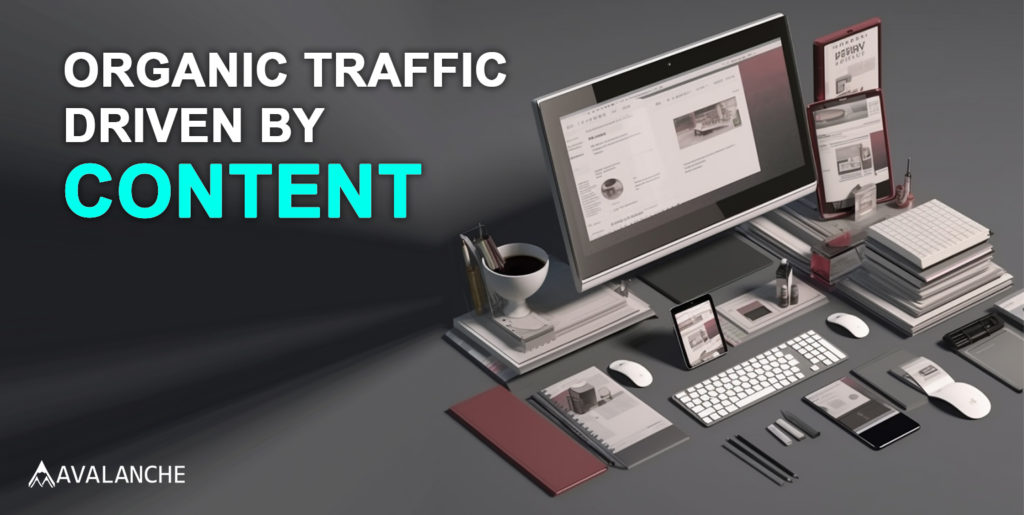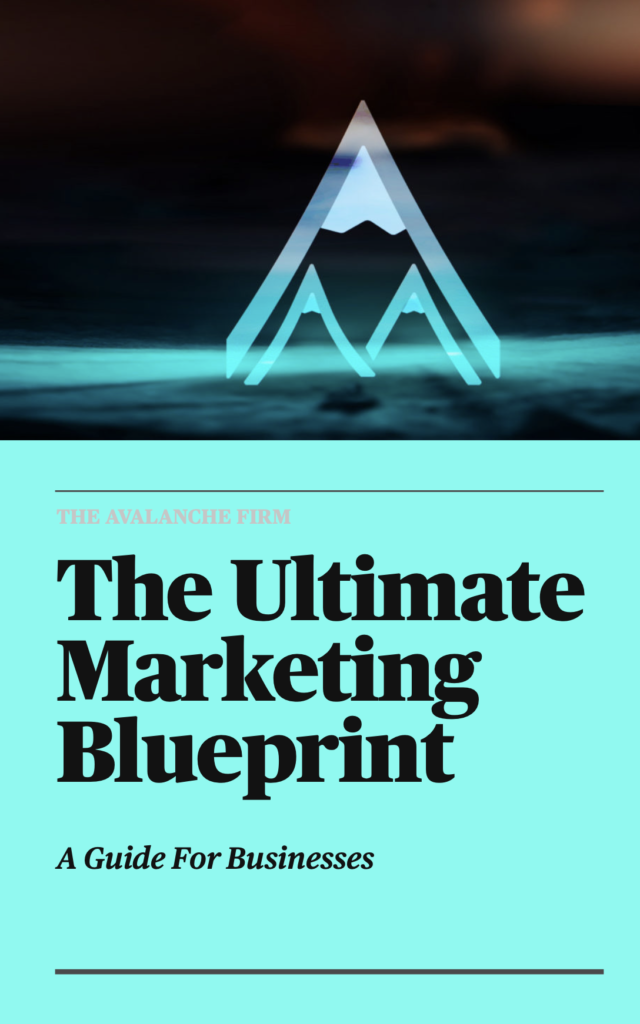In today’s digital landscape, content marketing has become an integral component of successful SEO strategies. It’s no longer enough to simply optimize your website for search engines; you also need to create high-quality, valuable content that attracts and engages your target audience. Today, we’ll explore content-driven SEO techniques and show you how to create valuable content that drives organic traffic to your website.
Research and Keyword Optimization
Keyword research for content marketing strategy
Let’s say you’re an injury law firm looking to create content that attracts potential clients to your website. The first step is to conduct thorough keyword research to identify the terms your target audience is likely to search for. Start by brainstorming a list of topics related to your business, such as “personal injury lawyer,” “car accident attorney,” or “workers’ compensation claims.”
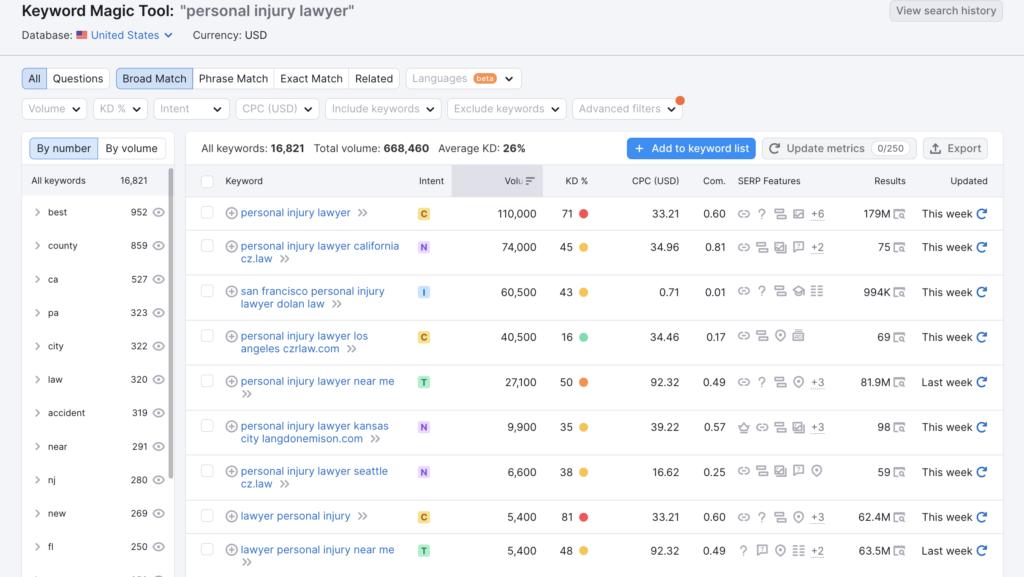
Next, use keyword research tools like Google Keyword Planner, SEMrush, or Ahrefs to find relevant, high-volume keywords with low to moderate competition. These tools can help you discover long-tail keywords and phrases that your target audience may be using to find information about injury law, such as “how to find a personal injury lawyer near me” or “steps to take after a car accident.”
Analyzing competition and search intent
Once you have a list of potential keywords, it’s essential to analyze your competition and understand the search intent behind these terms. Search intent refers to the reason why users are searching for specific keywords, such as:
- Looking for information
- Trying to make a purchase
- Seeking a particular website
For example, someone searching for “car accident attorney” likely has a different intent than someone searching for “steps to take after a car accident.” The first searcher may be looking to hire an attorney, while the second may be seeking general advice or guidance.
By understanding the search intent, you can create content that addresses the specific needs of your target audience. This approach increases the likelihood that they’ll find your content valuable and relevant.
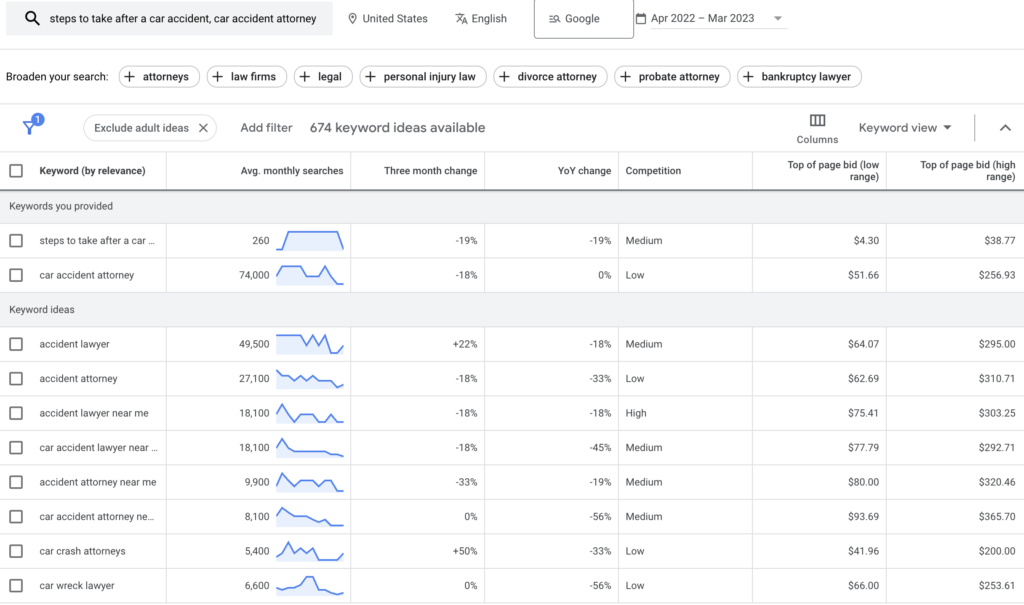
To analyze your competition, search for your target keywords on Google and examine the top-ranking pages. Pay attention to the content they provide, the structure of their articles, and any gaps or missing information you can address in your own content. By offering unique insights or covering topics your competitors have missed, you can create content that stands out and attracts more organic traffic.
Avoid Keyword Stuffing
When creating your content, it’s important to incorporate your target keywords naturally and strategically. Avoid keyword stuffing or using keywords in an unnatural or forced way, as this can harm your SEO and make your content difficult to read.
Exactly What Your Website Shouldn’t Do
Injured At Work?
We Are The Best Injury Lawyers In Town
Welcome to Best Injury Lawyers Firm! Are you looking for the top injury lawyers in town? Look no further than our injury law firm, where our experienced injury lawyers are ready to help with your car accident case, slip and fall case, and any other personal injury case you have. We are the best injury law firm in town with the best injury lawyers.
At our injury law firm, our injury lawyers specialize in car accident cases, motorcycle accident cases, truck accident cases, and more. You can trust our injury lawyers to provide expert legal advice and fight for your rights. Our injury lawyers have a proven track record of success in winning personal injury cases.
Don’t wait any longer to get the compensation you deserve. Contact our injury lawyers today to schedule a free consultation with one of our expert injury lawyers. Remember, we are the best injury law firm with the best injury lawyers in town.
This example demonstrates keyword stuffing by repeatedly using the terms “injury lawyers” and “injury law firm.” It’s essential to avoid such overuse of keywords and focus on creating high-quality, informative content that naturally incorporates your target keywords.
Injured At Work?
Incorporating target keywords naturally
Instead, include your primary keyword in your title, headings, and meta description. Sprinkle your secondary and long-tail keywords throughout the body of your content, ensuring they flow seamlessly within the text.
Example Keyword: “Car accident attorney.”
Example Text: “Hiring a car accident attorney can significantly improve your chances of receiving fair compensation for your injuries and damages.”
Remember, the primary goal of your content is to provide value to your readers, so focus on creating informative, engaging content that addresses their needs and concerns. By incorporating your target keywords naturally and strategically, you can improve your SEO without sacrificing readability or user experience.
Creating SEO-friendly Content
High-quality, informative, and engaging writing
When creating content for your business, it’s crucial to prioritize high-quality, informative, and engaging writing. This will not only attract readers but also demonstrate your expertise and authority in the field. Share valuable insights, explain complex legal concepts in a simple manner, and use real-life examples to make the content relatable to your audience. By doing so, you’ll build trust with your readers and encourage them to take the next step, such as contacting your firm for a consultation.
Readability: short paragraphs, subheadings, bullet points, and images
To improve the readability of your content, consider these strategies:
- Use short paragraphs: Breaking up large blocks of text makes it easier for readers to skim through the content and find the information they’re looking for.
- Subheadings: These can help guide readers through your article and highlight key topics.
- Bullet points: Summarize important points for quick reference.
- Images: Support your message and create visual interest.
For example, if you’re writing about the different types of personal injury cases:
- Categorize them with subheadings (e.g., “Car Accidents,” “Slip and Fall Injuries,” “Medical Malpractice”).
- List essential details using bullet points, such as common injuries or potential compensation.
- Include relevant images to illustrate each type of case.
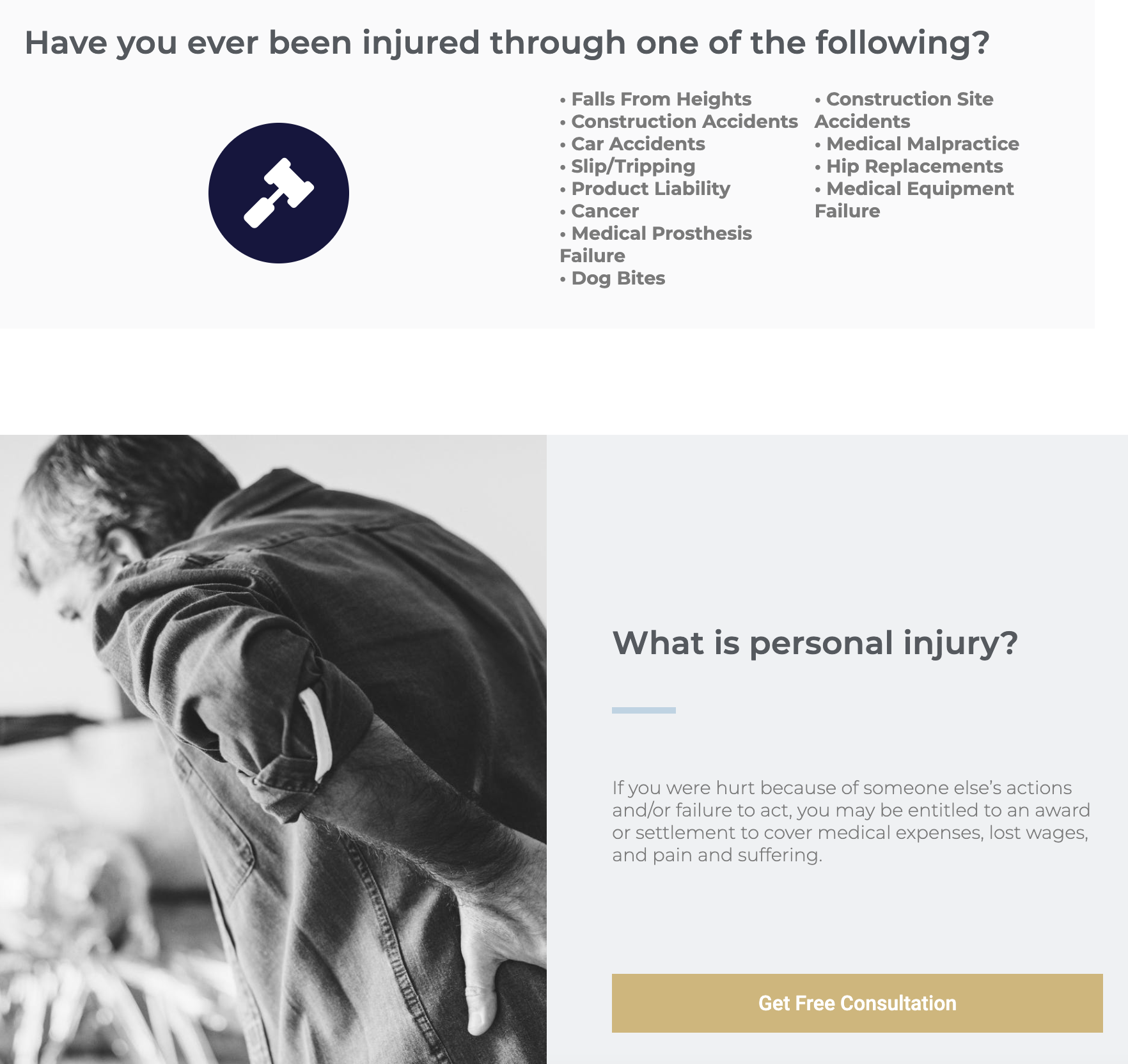
Optimizing images with descriptive file names and alt tags
Optimizing your images is an often overlooked aspect of SEO-friendly content. Use descriptive file names and alt tags to help search engines understand the content of your images. This not only boosts your SEO but also aids in accessibility for visually impaired users.
To optimize images for better readability and SEO, follow these tips using a car accident scene image as an example:
- File name: Instead of a generic name like “image1.jpg,” use a descriptive name like “car-accident-scene.jpg.”
- Alt tag: Include a descriptive alt tag, such as “Car accident scene with damaged vehicles.” This helps with accessibility and search engine understanding.
Adding internal and external links related to boosting organic traffic with content
Incorporate internal and external links within your content to help search engines understand the context and relevance of your article. Link to other relevant pages on your website, such as your practice areas, case studies, or client testimonials. This can help keep readers engaged and encourage them to explore your site further.
Additionally, link to authoritative external sources, such as legal directories, government websites, or industry publications, to support your claims and provide additional resources for your readers.
Mobile-friendly design and fast page load speed
Ensure that your blog is responsive and displays well on mobile devices, as search engines prioritize mobile-friendly websites in search results. Additionally, optimize your page load speed by compressing images, minimizing JavaScript and CSS files, and using a fast hosting service. A fast-loading, mobile-friendly website enhances the user experience and can lead to better search rankings.
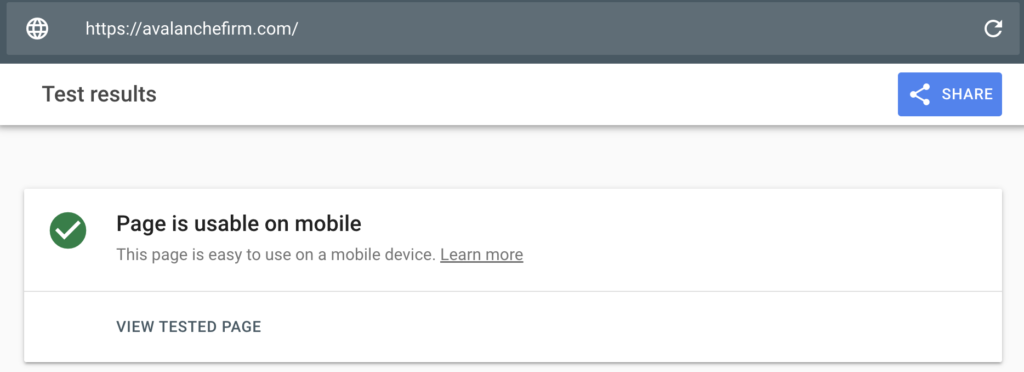
By following these guidelines when creating SEO-friendly content for your business, you’ll improve your chances of ranking higher in search engine results and attracting more potential clients to your website.
Measuring and Refining Your SEO Content Strategy
Tracking blog performance with Google Analytics
To assess the effectiveness of your SEO content strategy, track your blog’s performance using Google Analytics. This tool will provide valuable data, such as the number of visitors, average session duration, bounce rate, and conversion rate. By monitoring these metrics, you can identify areas for improvement and make informed decisions about your content marketing efforts.
Adjusting and refining your content-driven SEO techniques
Based on the insights gathered from Google Analytics, make necessary adjustments to your content-driven SEO techniques. This may involve updating your target keywords, improving readability, optimizing images, or adding more relevant internal and external links. Continuously refining your strategy will help you maintain and improve your search engine rankings over time.
Staying up-to-date with SEO best practices
SEO is an ever-evolving field, with search engines constantly updating their algorithms to provide better search results for users. Stay informed about the latest SEO best practices and industry trends to ensure your content strategy remains effective and competitive. This may involve subscribing to industry newsletters, attending webinars, or following thought leaders in the SEO space.
Bringing It All Together
By implementing a well-researched and carefully crafted SEO content strategy, you can drive organic traffic to your injury law firm’s website and attract more potential clients. At Avalanche, we understand the importance of creating valuable content that not only ranks high in search engine results but also resonates with your target audience. Our team of experienced SEO and content marketing specialists can help you develop a winning strategy that elevates your online presence and drives business growth. Contact us today to learn more about our comprehensive SEO and content marketing services.

Need Marketing Help For Your Business?
Get your free landing page review when you sign up for our free marketing consultation

